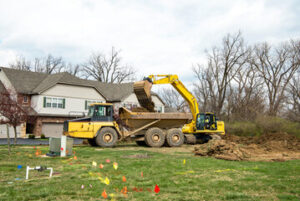An excavation contractor is responsible for the initial preparation of construction sites. They use advanced equipment like bulldozers, backhoes, and compactors to transform raw land into a foundational building site. Keep reading the article below to learn more about Excavating Contractor.

Choose a contractor that offers competitive pricing and provides a detailed quote. Ask about their licensing, safety record, and past work.
Site preparation entails a myriad of essential tasks that set the stage for construction projects. These include land clearing, demolition, excavation, and grading. Contractors are also responsible for trenching and installing underground utilities like water, sewer, gas, and electricity. Careful planning and precise work are essential to ensure the success of this critical phase.
Contractors must adhere to strict environmental, safety, and construction standards when preparing a construction site. In addition, they must have access to a variety of specialized equipment and tools that help them complete their work more efficiently. This includes earthmoving machinery, such as tractors, excavators, and bulldozers. These machines can dig and move large amounts of dirt in a short amount of time. They can also clear sand, gravel, and rocks. They may also install water, sewer, and electrical lines in the area before construction starts.
During this phase, contractors should assess the site’s soil composition and determine any potential issues with laying foundations or other structures. This step also involves ensuring proper drainage to avoid pooling water or flooding the site. Contractors can accomplish this by digging trenches and directing drainage away from the building site.
When hiring an excavation contractor, look for one with a proven track record of success and quality work. Checking their credentials is a must, as well as asking for client references and reviewing their past projects. A diverse range of services is also an indicator that a contractor is skilled and knowledgeable in many aspects of the job.
When hiring an excavator, remember to always keep safety first. Make sure that the contractor is licensed and has the necessary insurance to protect yourself and your property. It’s also a good idea to get estimates and projected timelines in writing, as this will prevent you from being taken advantage of by unethical contractors. Also, make sure to ask the contractors who will be handling any necessary permits for your project. This could save you from costly fines or delays in the project’s completion.
Leveling the Terrain
The construction of roads, buildings, and public utilities requires extensive excavation. Although excavating contractors only make up a small portion of overall site preparation, they play a critical role in laying the groundwork for these projects and ensuring that they are built to comply with safety and regulatory standards. Their work also lays the foundation for these structures to thrive and meet their functional goals.
In addition to digging holes for the foundation and trenching for utility lines, excavation contractors also level and grade the land. This involves adjusting the slope and elevation of the land to ensure proper drainage, protect the structural integrity of the building, and facilitate efficient construction. When necessary, the contractor may also employ stabilization techniques to improve the load-bearing capacity of the soil.
When building roads, an excavating contractor must also ensure that the road is safe for vehicles to travel on and equipped with adequate drainage systems. This includes grading the road, creating and repairing gullies, and managing drainage to prevent erosion and other problems. In addition, they often coordinate with paving teams to complete the construction of the asphalt road surface.
An important aspect of their work is to notify local utility providers before beginning any significant excavation on a construction site. This ensures that they do not accidentally damage gas, water, electricity, or other lines that run beneath the ground. While many homeowners have the right equipment to do this work themselves, it is often best left to a professional excavation contractor that has proper insurance coverage for all of their heavy machinery.
In addition to preparing the site, an excavating contractor is responsible for removing trees, shrubs, and other debris from the construction area. This is often a time-consuming process that can be made even more difficult by the presence of underground utilities or other factors that require specialized care. The contractor will typically use large, powerful machines such as backhoes or bulldozers to remove any obstructions and dispose of them properly.
Integrating Vital Infrastructure
Whether digging holes for foundations, creating trenches for utility lines or digging ditches for water and gas lines, excavation contractors are responsible for laying the groundwork for vital construction projects across communities. In addition to ensuring that the soil is contoured, stable and properly graded, excavating contractors also manage underground utilities and strategically plan sites to support the weight and structure of future buildings and infrastructure.
While excavation work often represents a small fraction of a construction project, it is critical to achieving success. By carefully planning and executing the necessary dig requirements, excavation contractors can help ensure that construction timelines are met and costs are kept within budget.
In order to ensure that excavation projects are completed safely and with maximum efficiency, it is imperative that all relevant safety protocols are followed. Throughout the entire excavation process, the proper use of equipment is key to reducing accidents and injuries. With that in mind, it is important to hire excavation contractors who follow proper safety guidelines and provide training to their crews.
When hiring an excavation contractor, it is important to ask about their insurance coverage. In the event that any damage is caused to your home, business or property during a dig, you want to be sure that the excavation contractor has the proper insurance coverage in place to cover these expenses.
It is also important to ask an excavation contractor about their permit procedures. Some excavation companies require that property owners pull their own permits while others handle this in-house. Having this information upfront will avoid any miscommunications and potential delays that may arise from improper permit processing.
Integrating vital infrastructure is a major responsibility for excavation contractors, as it allows construction activities to progress unhindered. By safely housing all utility services underground, excavation contractors can reduce the number of interferences that may delay project timelines and overall construction efficiency. Ultimately, this streamlined approach is an effective way to promote safer, more responsible and forward-thinking construction practices.
Preparing the Foundation
Once all the land clearing and soil preparation have been completed, the excavating contractor digs the foundation trenches that will support a new building. This is an extremely important step, and a mistake here can lead to serious structural problems in the future. This is why it’s so essential to have a professional excavating contractor handle the job.
During this phase, the contractor may also use tools like theodolites to mark foundation corners and precisely pinpoint their measurements. This ensures the site complies with architectural blueprints and other construction specifications. Management of excavated material is another aspect that requires careful attention, as the contractor will need to create designated zones for storing usable fill and removing waste. It’s also necessary to manage access to the site, with signs and physical barriers erected where appropriate to prevent vehicular accidents from occurring on construction sites.
As the construction of a new building begins, the excavation contractor will use the data they’ve collected during the pre-construction phase to help plan the most efficient path forward. This includes planning for the placement of underground utility lines, such as water, sewer and gas, so that they don’t interfere with future building work or cause structural instability.
In addition, the excavation contractor can prepare trenches and other earthwork needed for utilities installation, including grading to correct drainage problems that could otherwise cause flooding or water logging. This service is a valuable investment that protects against costly mistakes that can halt progress on other construction stages.
Excavating contractors are highly specialized professionals who have the skills and equipment to effectively clear terrain, level the ground, dig foundation footings and more. Their expertise in soil makeup and condition, weather conditions and more ensures a smooth project process from start to finish. If you are looking for an excavation contractor, ask them about their experience in the specific type of work you require. They should be able to tell you whether they will need a permit for your project and assist with arranging the necessary paperwork. Also, check their safety record to make sure they adhere to strict industry standards.


